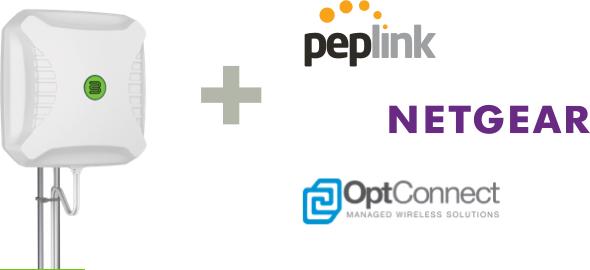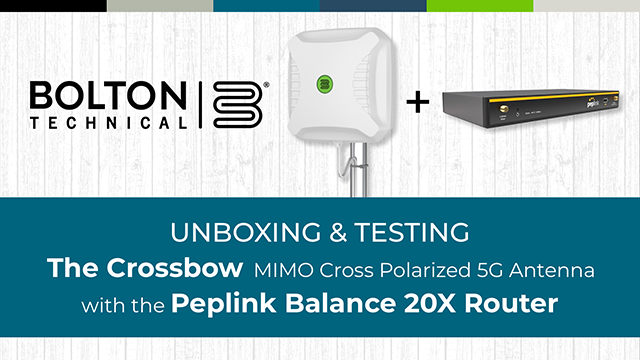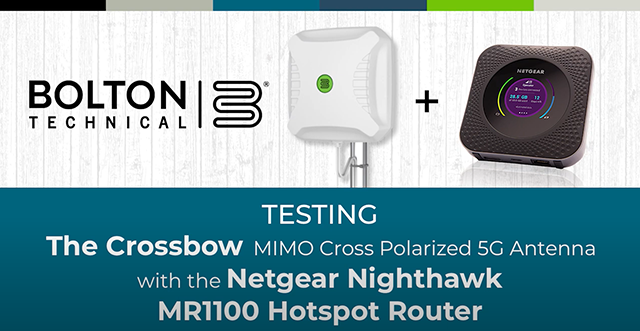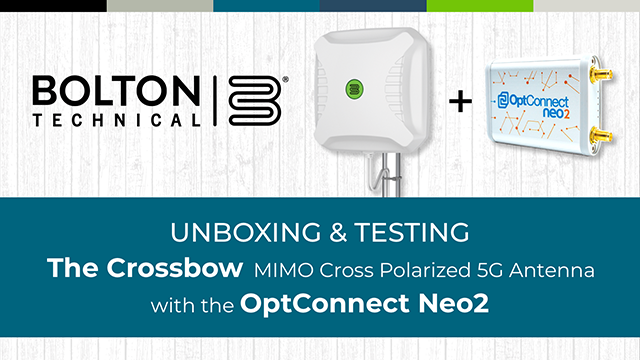
Testing The Crossbow 5G MIMO Antenna
Testing the Bolton Technical Crossbow 5G MIMO cross-polarized antenna with Peplink, NETGEAR, and OptConnect Cellular Routers
The Bolton band of brothers took our latest antenna that is taking the market by storm – The Crossbow 5G, a cross-polarized MIMO antenna – out for some real-world testing in the gorgeous and very remotely located Fireside Ranch out near Round Top, Texas.
The setting was picturesque, the sun was out, the heat blazed and some typical summer Texas showers all came together to really put The Crossbow through rigorous testing as we paired our beloved MIMO antenna with some of the IoT world’s most popular cellular routers.
Before we walk you through the results, we know some folks may want a primer – so let’s get your geek on and walk through a few things ahead of the Bolton Technical test results so that you, too, will walk away an expert once you read this blog… And you can then spend your family dinner highlighting your new knowledge to everyone at the table who will listen!
Want to skip the learning section and get to the meat-and-potatoes? Select the router that you want to see the results on:
[Peplink Balance 20X] [Peplink Max BR1 Mini] [NETGEAR Nighthawk] [NETGEAR Orbi] [OptConnect Neo2]
First, What the Heck is MIMO, anyway?
This is the one us folks at Bolton Technical get asked a lot – pronounced as “My-Moe” it simply means Multiple-In / Multiple-Out. The idea is pretty simple: you use multiple antennas (receivers) and multiple outputs (transmitters) to enhance performance.
While we at Bolton Technical would LOVE to take credit for this awesome idea, the fact is that it’s a concept pioneered in the 1970s but really came to life as all of us became more inter-connected.
You see, with MIMO, we take advantage of multiple transmitters and receivers (multiple antennas) on wireless devices for improved performance. When two transmitters and two or more receivers are used, two simultaneous data streams can be sent, which double the data rate. Multiple receivers alone allow greater distances between devices. For example, the IEEE 802.11n (Wi-Fi) wireless standard uses MIMO to increase speed to 100 Mbps and beyond, doubling at minimum the 802.11a and 11g rates. MIMO antennas are also used in WiMAX and LTE.
The enhanced performance The Crossbow delivers is a result of MIMO’s ability to introduce higher quality throughput – in terms of both the quality and quantity of data sent. Think about it – more antennas act like a layer of redundancy you don’t get in a classic single-antenna system. So you’re giving the system a chance to hedge your bets against lost data, fading of signal, and all the nasty things you don’t want in your connection.
What is download speed? Why does it fluctuate?
Ask anyone who games a lot – they will tell you download speed is that thing they never get enough of. Truth is that all “download speed” refers to the speed (usually in megabits of data per second) that your data pipes from a server, another computer, or wherever on the internet you are pulling data “down” from and into your devices on your network.
- Refers to how many megabits of data it takes to download data from a server to your device;
- This data can come in the forms of images, videos, text files, audio files, emails, and so on;
- Activities like listening to a song by Cardi B or watching the latest season of Succession on HBO MAX all require you to download data;
- Download speeds depend on everything from the source server, the speed of the server's ISP connection, the speed of the path through the Internet, the speed of YOUR ISP, and also the speed of the device handling the download!
Download speed fluctuates for any number of reasons. Think of it like a highway – folks go to work at the same time, they come home around the same time, and how the internet works is kind of the same way. More people on the “digital highway” means more traffic, which means speeds can drop - folks logging in for work, having to interface with their work's VPN, major media press releases, etc. - all can clog up the highway. Ditto every time a major release drops at a certain time on Netflix or any streaming service that EVERYONE has to see. You will see a drop in speed - no doubt you will experience in the form of the buffering icon.
So What is Upload Speed?
Think of it as the opposite of download: you are sending stuff “up” to something. The cloud, another computer, to your server at work, your Facebook Family Photo Album... whatever. It’s leaving your home or business network (and the devices on it) and beaming the stuff out to the great world wide web.
What Does "Ping" Mean? I have heard of that, too...
Ah, Ping – this time, without the Pong. In our case, “Ping” refers to the amount of time – measured in the seriously small unit of time known as the millisecond (ms) – it takes for a small amount of data to be transferred from, say, your laptop to a server and back again via the Internet. Because it is measuring a literal round-trip of data, a lot of folks see it as highly relevant when talking about overall internet usage.
How We Connected the Crossbow 5G MIMO Antenna During Testing
First thing is first... you should know that Bolton Technical offers The Crossbow 5G in TWO different versions – one comes with two fifteen-foot runs of cable that are terminated with SMA Male connections (SKU BT974976), the other version has no cable though has two N-Female ports on the back panel (SKU BT151052). For the purposes of our testing The Crossbow out at the lovely Fireside Ranch, we used The Crossbow with SMA Male connections. Where needed, we used adapters to convert the SMA Male to TS-9 Connections in order to plug them into the cellular routers (our YouTube Channel Playlist on these tests will dive into that information as needed - letting you know what we did, and how we did it).
Speed Testing: We Used Speedest.net by Ookla
We stuck with the tried-and-true Speedtest.net site by Ookla to run all of our download and upload tests with each of the five popular cellular routers that we plugged The Crossbow into. Ookla’s speedtesting service is one of the most relied upon testing services globally. As of this blog’s posting, over 37.5 billion tests have been run on Ookla’s signature platform, Speedtest.net, and we wanted to stick with the platform all our fellow Boltonites would know.
The Crossbow 5G Paired With the Peplink Balance 20X Router

Click on the image above to see the Full Video on YouTube
About the Peplink Balance 20X Router
- Manufacturer: Peplink
- Product: The Balance 20X Router
- 900 Mbps Stateful Firewall Throughput
- 100 Mbps PepVPN Throughput (no Encryption)
- 60 Mbps PepVPN Throughput (256-bit AES)
- 1 WAN / 4 LAN Ports
- Carrier Used on Test: Verizon
Overall, How It Went:
AWESOMELY WELL! The Fireside Ranch out at Round Top, Texas was reading about -113dB for Cell Signal (using the Network Cell App, available at the Android and Apple stores), so this was going to be a challenge for any cellular router that one uses in a remote countryside. Using the Ookla Speedtest throughout, we ran one test on Peplink’s Balance 20X router (on a Verizon SIM Card) without The Crossbow 5G MIMO antenna, then one with. Results as follows:
Before The Crossbow 5G was Plugged In
Download
We saw Download speeds out in this beautiful, quiet, and remote countryside ranch hit about 12.25 Mbps on the Verizon Network using the Peplink Balance 20X’s rubber duck antennas. The engineers at Peplink know their stuff, and for this awesome cellular router to get that much way out here was a remarkable feat!
Upload
The Upload speed was actually pretty good – and to be expected given Peplink’s reputation for quality engineering in their products. The Balance 20X hit 10.15 MBps on the Upload.
After The Crossbow 5G was Plugged In
Download
The Crossbow 5G MIMO cross-polarized antenna took the Peplink Balance 20X to a whole new level of speed out here at the Fireside Ranch – delivering 40.07 MBps on Download when these two greats were paired together.
Upload
End of the day, cellular at a distance in the beautiful countryside of Round Top, Texas can be slow on Uploads. We clocked in at 7.81 Mbps. Overall, a success given that we literally blew the roof off the Download, which is where a vast majority of folks expect the ramp-up to occur.
The Crossbow 5G Paired With the Peplink Max BR1 Mini

Click on the image above to see the Full Video on YouTube
About the Peplink Max BR1 Mini Router
- Manufacturer: Peplink
- Product: Max BR1 Mini Router at our partner site SignalBoosters.com
- 100 Mbps Stateful Router Throughput
- 40 Mbps PepVPN Throughput (no Encryption)
- 20 Mbps PepVPN Throughput (256-bit AES)
- 1 WAN / 2 LAN Ports
- Carrier Used on Test: Verizon
Overall, How It Went:
First, we cannot say enough great things about the peeps at Peplink – great out of the box, fabulous engineering and they just are spot on in all that they do. For those wondering, on this one we did not Ethernet into the Max BR1 – we went WiFi to it from our laptop as we conducted our Ookla Speedtest for both rounds (we did use a Verizon SIM card on this one - given that we had been using it often before today, we anticipated some throttling).
Before The Crossbow 5G was Plugged In
Download
Download speeds clocked in at 18.86 Mbps without plugging in The Crossbow 5G MIMO cross-polarized antenna form our Bolton Technical team – showing once again that Peplink put some punch into the Max BR1 Mini Router (as they do with every one of their products).
Upload
Upload test yielded 11.69 Mbps (not shabby way out at the Fireside Ranch outside of Round Top, TX).
After The Crossbow 5G was Plugged In
Download
Of course now comes the fun – we plugged the SMA male connectors that come with the version of The Crossbow 5G MIMO antenna that we brought with us (there are two versions, remember – one that comes with two runs of 15-feet of cable with SMA Male connectors at the end, and another version of The Crossbow that has N-Female ports with no cables) – and fired up our test with the Max Peplink BR1 Mini Router. Result was a robust kick up to 25.75 Mbps
Upload
We once again hit the Verizon oddball throttle on this one (and no doubt because we had been using the same Verizon card for some time) and our beloved antenna did fall short. The Upload clocked in at 3.90 Mbps. Cue the sad Price Is Right music right here.

The Crossbow 5G Paired With the NETGEAR Nighthawk

Click on the image above to see the Full Video on YouTube
About the NETGEAR Nighthawk
- Manufacturer: NETGEAR
- Product: Nighthawk MR1100 Hotspot Router
- Max Download Speeds of up to 1 Gbps
- Max Upload Speeds of up to 150 Mbps
- 1 Ethernet Port
- USB Ports: 1 Type C / 1 Type A
- Antenna Connectors: 2 TS-9 Connectors
Overall, How It Went:
SUCCESS!!! Before initiating the test, the Nighthawk MR100 wasn’t producing any WiFi – zip, zilch, nada. After paring The Crossbow with the Nighthawk MR100 Mobile Router, however, download speeds octupled and upload speeds quadrupled (almost quintupled)! To make this magic happen, TS9 to SMA connectors were needed to connect the two units. The difference between our locations (as you will see in the video) is that we were at the AirBnB at fireside ranch – and our showcase today is a good reminder to all those AirBnB owners to think of adding Bolton Technical to your total customer experience package.
Before The Crossbow 5G was Plugged In
Download
Literally, nothing. Like the video showed, we had zero anything, no readings. We need to be clear - this was not a statement about NETGEAR. NETGEAR makes some awesome products used by countless Americans nationwide. This had more to do with the location, the weather (it was raining and cloud) and the structure we tested in on this round. Again, many folks see great results from the Nighthawk MR100 router in their day-to-day use. Just a reminder that our location out here in beautiful Round Top, Texas proves once again that sometimes where one is located can be the guiding factor in what sort of signal you get.
Upload
Again, zilch, zip, a goose egg, nada – just as we noted in the opening. A mix of weather, location, the building, everything.
After The Crossbow 5G was Plugged In
Download
We found this to be just all kinds of awesome – 8.14 Mbps. An 8x factor in improvement – especially in bad conditions like rain, long cell tower distance and more trees blocking the line of sight from the AirBnB out by the Fireside Ranch. This is an amazing uptick.
Upload
Again, we say 4x, but hey... 0 to 4.89 Mbps, that’s really more like 5x, right? Again, most impressive. Showing that Bolton Technical’s MIMO 5G antenna The Crossbow can really help you in nearly any situation!
The Crossbow 5G Paired With the NETGEAR Orbi Tri-Band Router

Click on the image above to see the Full Video on YouTube
About the NETGEAR Orbi Tri-Band Router
- Manufacturer: NETGEAR
- Product: The Orbi Tri-Band Router
- Max Download Speeds of up to 1.2 Gbps on 4G LTE
- Internal Antennas can Cover up to 2,000 sq ft (under perfect conditions)
- 1 WAN / 2 LAN Ports
- 2 LTE Antenna Connectors
- Carrier: T-Mobile
Overall, How It Went:
To conduct the test, we used a T-Mobile sim card (whose signal, by the way, was below average at our test site out by Round Top, Texas). We saw some robust results on this test - and before we get into the juicy Down/Up Mbps rates, it should be noted that The Crossbow 5G from Bolton Technical, once we connected the Orbi to it, was able to cut the Ping in half to the T-Mobile tower (ping measurement), which was a pretty impressive feat in and of itself.
Before The Crossbow 5G was Plugged In
Download
NETGEAR’s Orbi is one very fancy-schmancy looking piece of hardware – and we put this in a challenging situation out in the remote and gorgeous Fireside Ranch outside of Round Top, TX. So challenging, we only hit 1.21 Mbps on the T-Mobile SIM card.
Upload
As we said before, when we tested the NETGEAR Orbi we put it in a tough spot out here. Remote, hills, trees, everything you can throw at it. We clocked the test Upload in at 0.02 Mbps before we plugged in The Crossbow 5G MIMO cross-polarized antenna.
After The Crossbow 5G was Plugged In
Download
We plugged in Bolton Technical’s 5G MIMO antenna, The Crosswbow, into NETGEAR’s Orbi and we got some juice on the squeeze! We got 8.82 Mbps on the Download in some rough conditions out here at the Fireside Ranch. Most impressive.
Upload
Upload did continue to prove a challenge, though we were able to get in 0.31 Mbps on the test with The Crossbow 5G MIMO antenna plugged into the NETGEAR Orbi.
The Crossbow 5G Paired With the OptConnect Neo2

Click on the image above to see the Full Video on YouTube
About the OptConnect Neo2
- Manufacturer: OptConnect
- Product: Neo2
- LTE CAT 4
- Protocol Support: HTTP, HTTPS, FTP, SSL
- 2 Internal MicroSIM card slots
- 2 Ports / RJ-45 Connector
- 2 SMA Female Connectors
Overall, How It Went:
The test was out of this world good, taking a quality product from the minds at OptConnect and pairing it with The Crossbow 5G MIMO antenna from Bolton Technical was a great idea. Our own Bolton tech guru Chris H. already had been crushing on the Neo2 (rightfully so) so when we told him were heading out to test this Fireside Ranch with our new bestselling antenna, he jumped at the chance to travel out towards Round Top, Texas for this.
Before The Crossbow 5G was Plugged In
Download
As we stated, for a wee sized omni-directional antenna, the OptConnect Neo2 packs a serious punch, and it did clock in at 11.03 Mbps – pretty good all-around engineering from OptConnect (and a testament to their antenna design).
Upload
The upload for the OptConnect Neo2 was clocked at 4.47 Mbps before we hooked up The Crossbow 5G MIMO cross-polarized antenna.
After The Crossbow 5G was Plugged In
Download
As always, Bolton Technical delivers. We took the tiny Neo2 and amplified its punch! On the Download side, after hooking up The Crossbow 5G we achieved 23.02 Mbps on the download speed. Not too shabby, literally more than doubling the initial test.
Upload
For once, we did not get the carrier throttle on the Upload! And in return, we showcased how the awesome OptConnect Neo2 can soar like an eagle by pairing it with our cross-polarized MIMO antenna, The Crossbow. We clocked 21.40 Mbps – a factor of almost 5X! Talk about two great things going great together – this was it from Bolton Technical and OptConnect.









